Taxation Theory, Practice & Law Assignment, Holmes Institute, T3 2019
VerifiedAdded on 2022/08/19
|9
|2264
|11
Homework Assignment
AI Summary
This document presents a comprehensive solution to a taxation assignment for Holmes Institute's HI6028 course. The assignment addresses two main questions. The first question analyzes the assessable income of an individual, considering various income sources like part-time employment, tips, gifts, and employer-provided meals. It applies relevant ATO guidelines and case laws to determine the taxability of each income component, ultimately calculating the individual's annual assessable income. The second question provides taxation advice on CGT transactions undertaken by a 65-year-old Australian woman, including the sale of her primary residence, car, small business, furniture, and paintings. It examines the applicability of CGT, considers small business concessions, and analyzes the tax implications of each transaction based on relevant legislation and ATO guidelines, concluding with the total assessable capital gains for the individual.
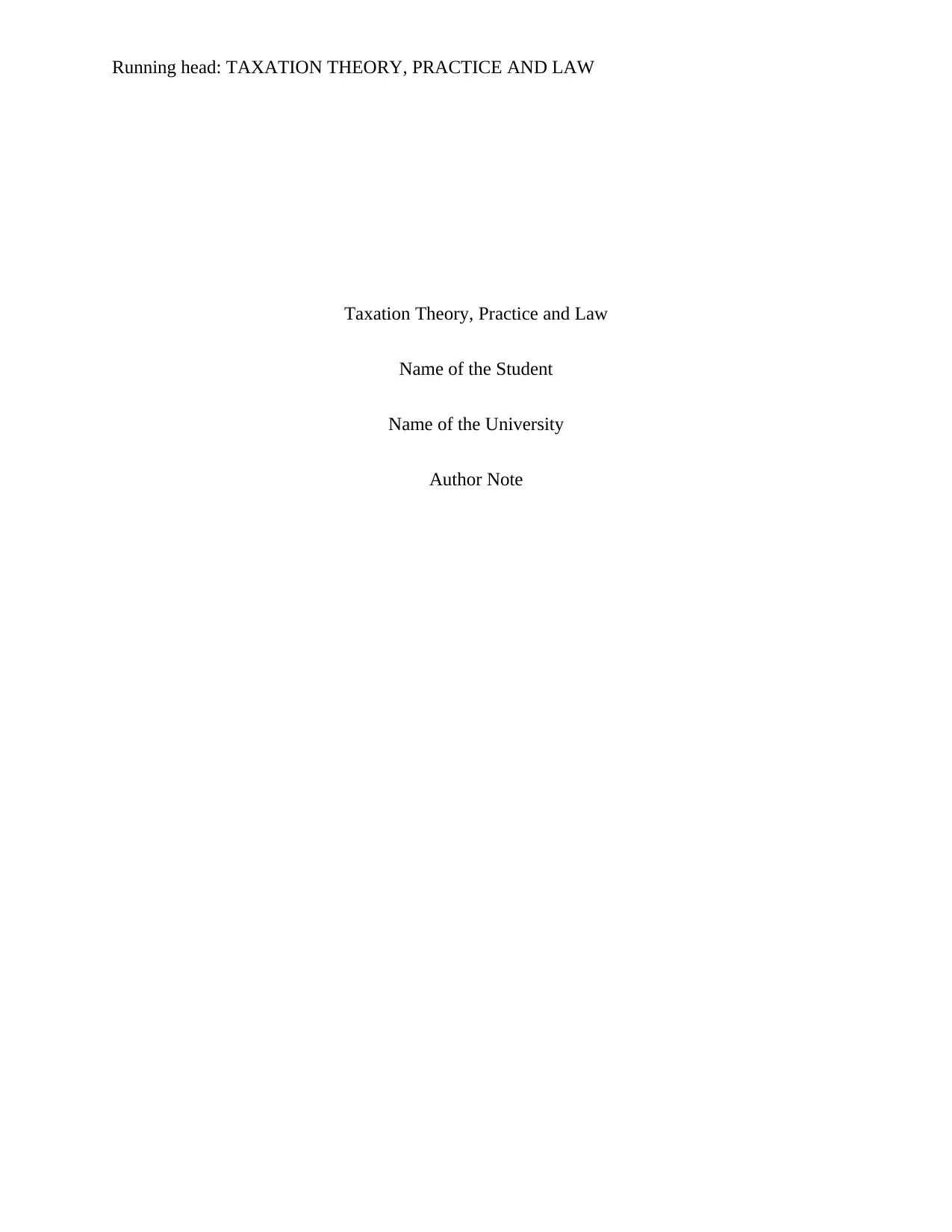
Running head: TAXATION THEORY, PRACTICE AND LAW
Taxation Theory, Practice and Law
Name of the Student
Name of the University
Author Note
Taxation Theory, Practice and Law
Name of the Student
Name of the University
Author Note
Paraphrase This Document
Need a fresh take? Get an instant paraphrase of this document with our AI Paraphraser
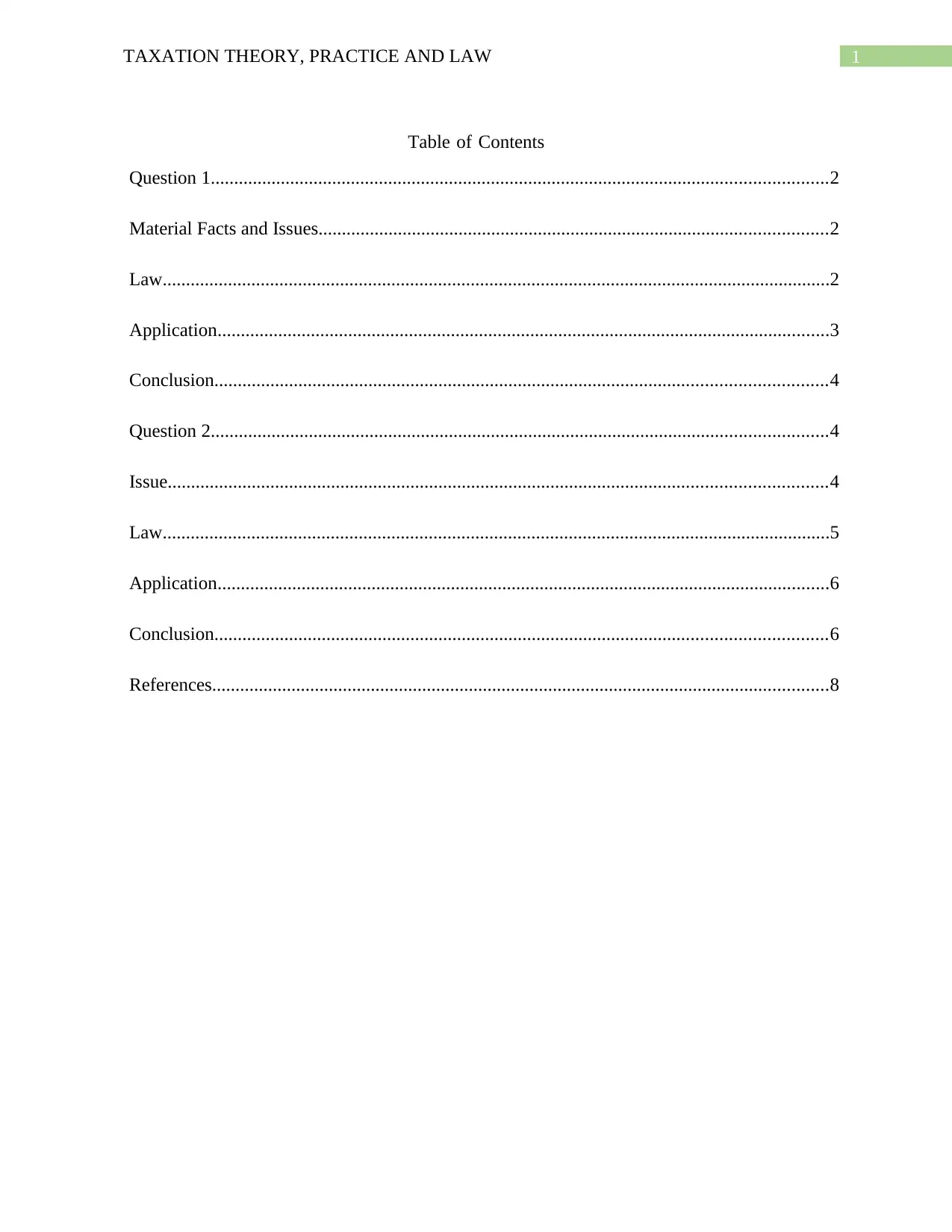
1TAXATION THEORY, PRACTICE AND LAW
Table of Contents
Question 1....................................................................................................................................2
Material Facts and Issues.............................................................................................................2
Law...............................................................................................................................................2
Application...................................................................................................................................3
Conclusion...................................................................................................................................4
Question 2....................................................................................................................................4
Issue.............................................................................................................................................4
Law...............................................................................................................................................5
Application...................................................................................................................................6
Conclusion...................................................................................................................................6
References....................................................................................................................................8
Table of Contents
Question 1....................................................................................................................................2
Material Facts and Issues.............................................................................................................2
Law...............................................................................................................................................2
Application...................................................................................................................................3
Conclusion...................................................................................................................................4
Question 2....................................................................................................................................4
Issue.............................................................................................................................................4
Law...............................................................................................................................................5
Application...................................................................................................................................6
Conclusion...................................................................................................................................6
References....................................................................................................................................8
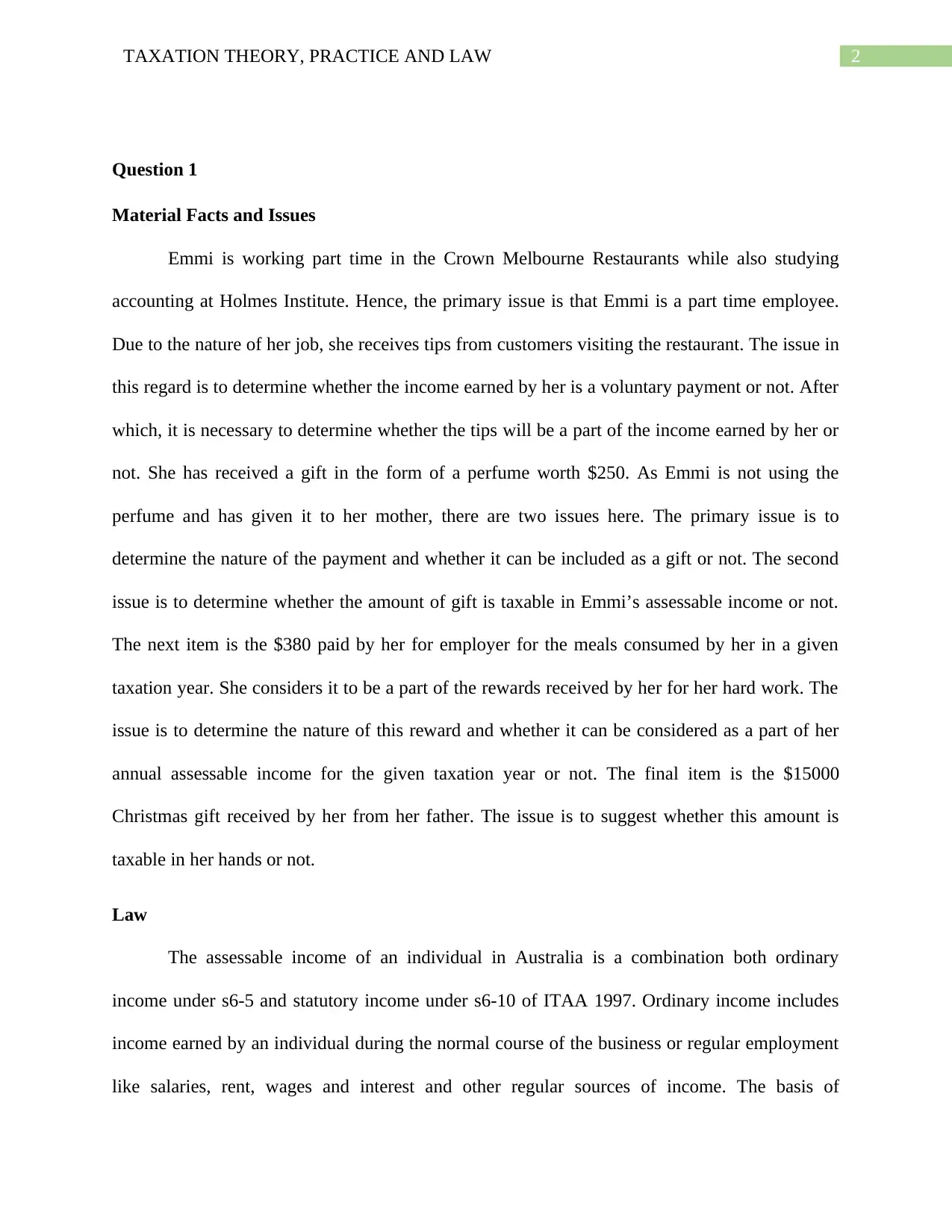
2TAXATION THEORY, PRACTICE AND LAW
Question 1
Material Facts and Issues
Emmi is working part time in the Crown Melbourne Restaurants while also studying
accounting at Holmes Institute. Hence, the primary issue is that Emmi is a part time employee.
Due to the nature of her job, she receives tips from customers visiting the restaurant. The issue in
this regard is to determine whether the income earned by her is a voluntary payment or not. After
which, it is necessary to determine whether the tips will be a part of the income earned by her or
not. She has received a gift in the form of a perfume worth $250. As Emmi is not using the
perfume and has given it to her mother, there are two issues here. The primary issue is to
determine the nature of the payment and whether it can be included as a gift or not. The second
issue is to determine whether the amount of gift is taxable in Emmi’s assessable income or not.
The next item is the $380 paid by her for employer for the meals consumed by her in a given
taxation year. She considers it to be a part of the rewards received by her for her hard work. The
issue is to determine the nature of this reward and whether it can be considered as a part of her
annual assessable income for the given taxation year or not. The final item is the $15000
Christmas gift received by her from her father. The issue is to suggest whether this amount is
taxable in her hands or not.
Law
The assessable income of an individual in Australia is a combination both ordinary
income under s6-5 and statutory income under s6-10 of ITAA 1997. Ordinary income includes
income earned by an individual during the normal course of the business or regular employment
like salaries, rent, wages and interest and other regular sources of income. The basis of
Question 1
Material Facts and Issues
Emmi is working part time in the Crown Melbourne Restaurants while also studying
accounting at Holmes Institute. Hence, the primary issue is that Emmi is a part time employee.
Due to the nature of her job, she receives tips from customers visiting the restaurant. The issue in
this regard is to determine whether the income earned by her is a voluntary payment or not. After
which, it is necessary to determine whether the tips will be a part of the income earned by her or
not. She has received a gift in the form of a perfume worth $250. As Emmi is not using the
perfume and has given it to her mother, there are two issues here. The primary issue is to
determine the nature of the payment and whether it can be included as a gift or not. The second
issue is to determine whether the amount of gift is taxable in Emmi’s assessable income or not.
The next item is the $380 paid by her for employer for the meals consumed by her in a given
taxation year. She considers it to be a part of the rewards received by her for her hard work. The
issue is to determine the nature of this reward and whether it can be considered as a part of her
annual assessable income for the given taxation year or not. The final item is the $15000
Christmas gift received by her from her father. The issue is to suggest whether this amount is
taxable in her hands or not.
Law
The assessable income of an individual in Australia is a combination both ordinary
income under s6-5 and statutory income under s6-10 of ITAA 1997. Ordinary income includes
income earned by an individual during the normal course of the business or regular employment
like salaries, rent, wages and interest and other regular sources of income. The basis of
⊘ This is a preview!⊘
Do you want full access?
Subscribe today to unlock all pages.

Trusted by 1+ million students worldwide
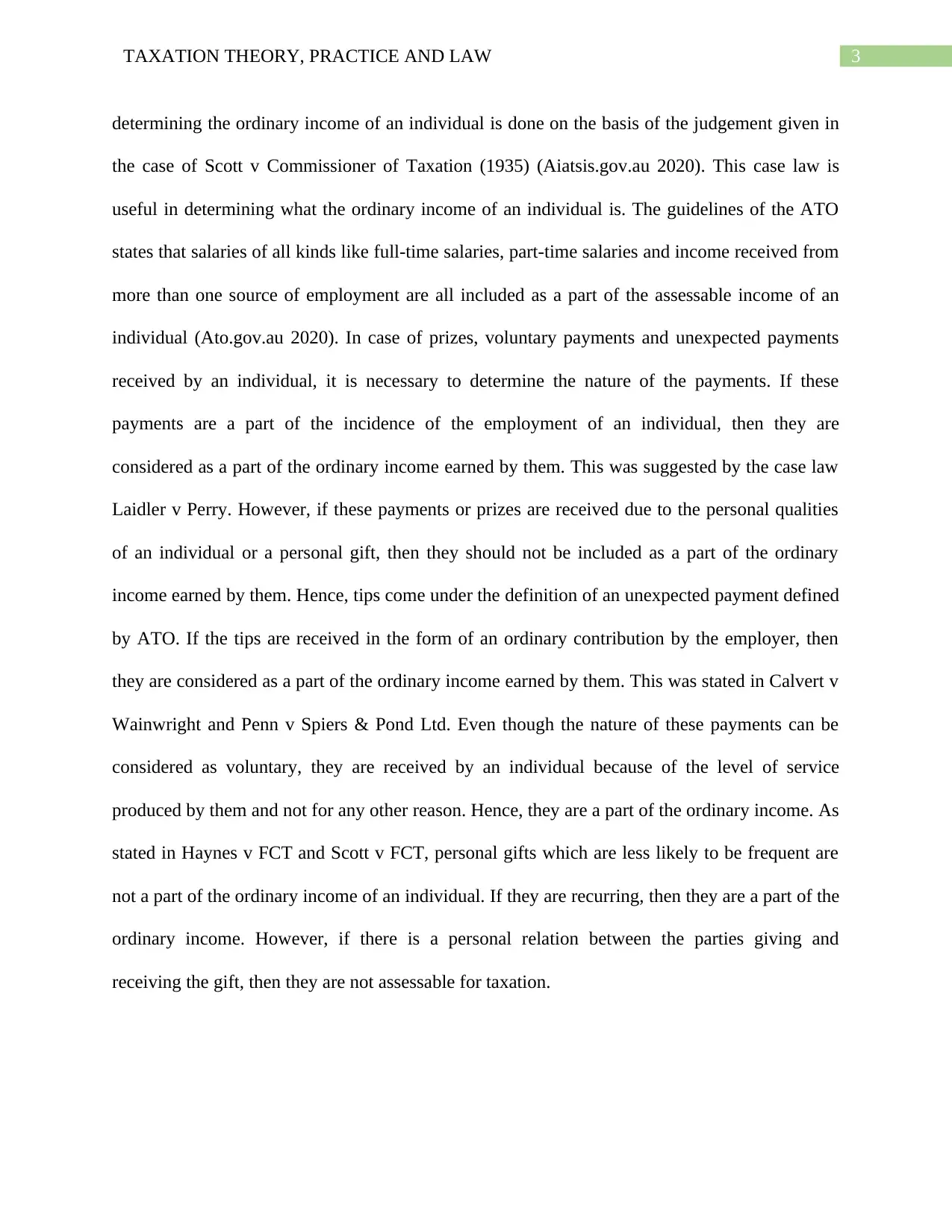
3TAXATION THEORY, PRACTICE AND LAW
determining the ordinary income of an individual is done on the basis of the judgement given in
the case of Scott v Commissioner of Taxation (1935) (Aiatsis.gov.au 2020). This case law is
useful in determining what the ordinary income of an individual is. The guidelines of the ATO
states that salaries of all kinds like full-time salaries, part-time salaries and income received from
more than one source of employment are all included as a part of the assessable income of an
individual (Ato.gov.au 2020). In case of prizes, voluntary payments and unexpected payments
received by an individual, it is necessary to determine the nature of the payments. If these
payments are a part of the incidence of the employment of an individual, then they are
considered as a part of the ordinary income earned by them. This was suggested by the case law
Laidler v Perry. However, if these payments or prizes are received due to the personal qualities
of an individual or a personal gift, then they should not be included as a part of the ordinary
income earned by them. Hence, tips come under the definition of an unexpected payment defined
by ATO. If the tips are received in the form of an ordinary contribution by the employer, then
they are considered as a part of the ordinary income earned by them. This was stated in Calvert v
Wainwright and Penn v Spiers & Pond Ltd. Even though the nature of these payments can be
considered as voluntary, they are received by an individual because of the level of service
produced by them and not for any other reason. Hence, they are a part of the ordinary income. As
stated in Haynes v FCT and Scott v FCT, personal gifts which are less likely to be frequent are
not a part of the ordinary income of an individual. If they are recurring, then they are a part of the
ordinary income. However, if there is a personal relation between the parties giving and
receiving the gift, then they are not assessable for taxation.
determining the ordinary income of an individual is done on the basis of the judgement given in
the case of Scott v Commissioner of Taxation (1935) (Aiatsis.gov.au 2020). This case law is
useful in determining what the ordinary income of an individual is. The guidelines of the ATO
states that salaries of all kinds like full-time salaries, part-time salaries and income received from
more than one source of employment are all included as a part of the assessable income of an
individual (Ato.gov.au 2020). In case of prizes, voluntary payments and unexpected payments
received by an individual, it is necessary to determine the nature of the payments. If these
payments are a part of the incidence of the employment of an individual, then they are
considered as a part of the ordinary income earned by them. This was suggested by the case law
Laidler v Perry. However, if these payments or prizes are received due to the personal qualities
of an individual or a personal gift, then they should not be included as a part of the ordinary
income earned by them. Hence, tips come under the definition of an unexpected payment defined
by ATO. If the tips are received in the form of an ordinary contribution by the employer, then
they are considered as a part of the ordinary income earned by them. This was stated in Calvert v
Wainwright and Penn v Spiers & Pond Ltd. Even though the nature of these payments can be
considered as voluntary, they are received by an individual because of the level of service
produced by them and not for any other reason. Hence, they are a part of the ordinary income. As
stated in Haynes v FCT and Scott v FCT, personal gifts which are less likely to be frequent are
not a part of the ordinary income of an individual. If they are recurring, then they are a part of the
ordinary income. However, if there is a personal relation between the parties giving and
receiving the gift, then they are not assessable for taxation.
Paraphrase This Document
Need a fresh take? Get an instant paraphrase of this document with our AI Paraphraser

4TAXATION THEORY, PRACTICE AND LAW
Application
Emmi is receiving the payments of $25000 from her job. Even though it is part time, it
has to be included as a part of the ordinary income earned by her due to the ATO regulations.
The tips of $335 received by her are due to the nature of the services provided by her, Even
though they are a voluntary payment, they need to be included as a part of the assessable income
of Emmi. The perfume received by her has more personal qualities attached to it. As the gift was
received on the occasion of Christmas and is unlikely to be continuous, it is not included as a
part of the assessable income. The monthly entertainment allowance is a part of the incidence of
employment and hence should not be included as a part of the assessable income. The Christmas
gift received from her father is personal and hence should not be included in her assessable
income for the income tax year.
Conclusion
From applying the relevant laws and guidelines of ATO to the case of Emmi, it can be
stated that her annual assessable income for the given taxation year is $25715(25000+380+335).
The gifts received from her father and the perfume gift received from the employer are not to be
included as a part of her assessable income for the given tax year.
Question 2
Issue
The issue in this case is to provide taxation advice on the CGT transactions undertaken
by Liu, a 65 year old Australian woman. The most relevant fact in this case is that she is carrying
on a small business and will be retiring after selling it. Her age is also an important factor in this
case. The date of purchase of her house property and the nature of her usage of the same are also
important issues. The nature of the usage of the car and whether it can be classified as a car is
Application
Emmi is receiving the payments of $25000 from her job. Even though it is part time, it
has to be included as a part of the ordinary income earned by her due to the ATO regulations.
The tips of $335 received by her are due to the nature of the services provided by her, Even
though they are a voluntary payment, they need to be included as a part of the assessable income
of Emmi. The perfume received by her has more personal qualities attached to it. As the gift was
received on the occasion of Christmas and is unlikely to be continuous, it is not included as a
part of the assessable income. The monthly entertainment allowance is a part of the incidence of
employment and hence should not be included as a part of the assessable income. The Christmas
gift received from her father is personal and hence should not be included in her assessable
income for the income tax year.
Conclusion
From applying the relevant laws and guidelines of ATO to the case of Emmi, it can be
stated that her annual assessable income for the given taxation year is $25715(25000+380+335).
The gifts received from her father and the perfume gift received from the employer are not to be
included as a part of her assessable income for the given tax year.
Question 2
Issue
The issue in this case is to provide taxation advice on the CGT transactions undertaken
by Liu, a 65 year old Australian woman. The most relevant fact in this case is that she is carrying
on a small business and will be retiring after selling it. Her age is also an important factor in this
case. The date of purchase of her house property and the nature of her usage of the same are also
important issues. The nature of the usage of the car and whether it can be classified as a car is
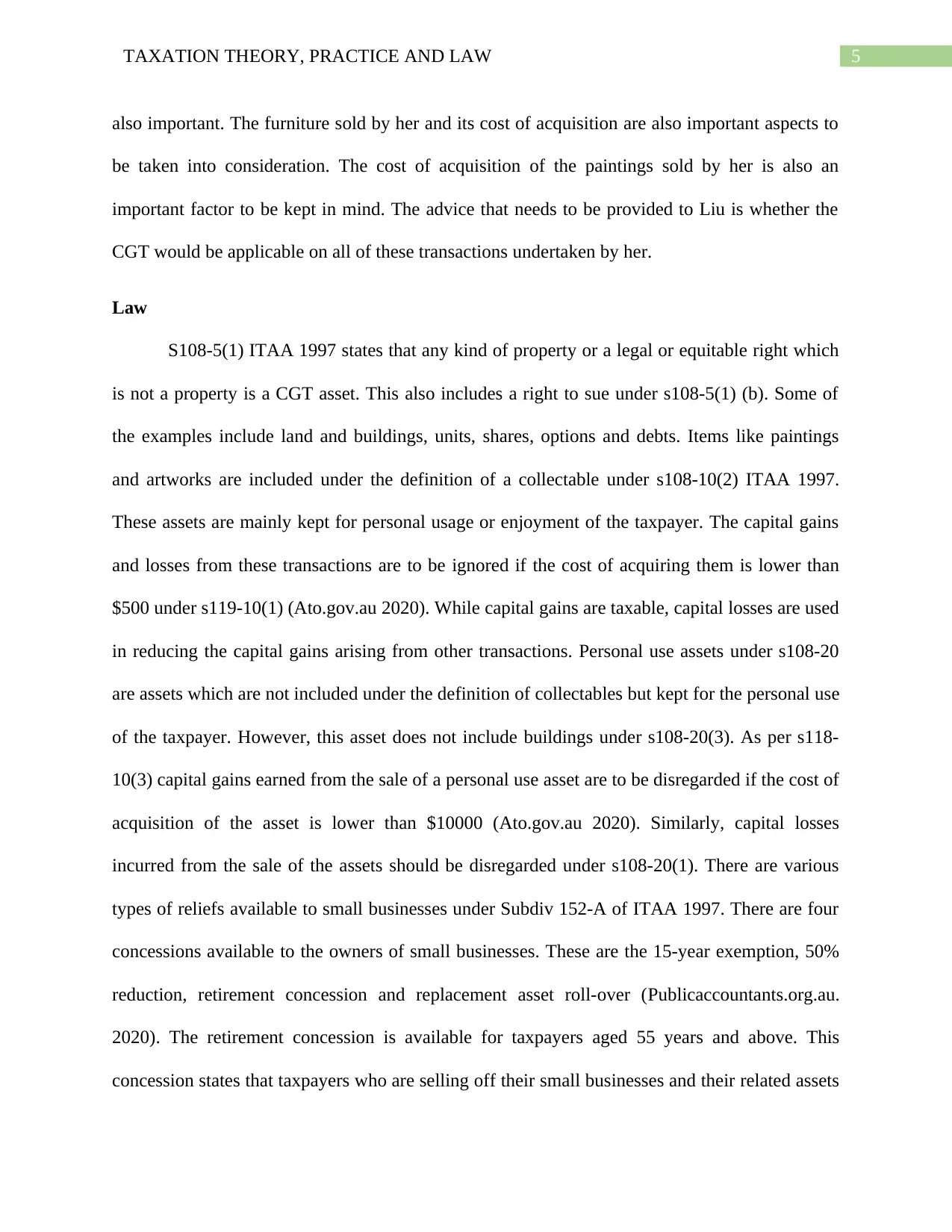
5TAXATION THEORY, PRACTICE AND LAW
also important. The furniture sold by her and its cost of acquisition are also important aspects to
be taken into consideration. The cost of acquisition of the paintings sold by her is also an
important factor to be kept in mind. The advice that needs to be provided to Liu is whether the
CGT would be applicable on all of these transactions undertaken by her.
Law
S108-5(1) ITAA 1997 states that any kind of property or a legal or equitable right which
is not a property is a CGT asset. This also includes a right to sue under s108-5(1) (b). Some of
the examples include land and buildings, units, shares, options and debts. Items like paintings
and artworks are included under the definition of a collectable under s108-10(2) ITAA 1997.
These assets are mainly kept for personal usage or enjoyment of the taxpayer. The capital gains
and losses from these transactions are to be ignored if the cost of acquiring them is lower than
$500 under s119-10(1) (Ato.gov.au 2020). While capital gains are taxable, capital losses are used
in reducing the capital gains arising from other transactions. Personal use assets under s108-20
are assets which are not included under the definition of collectables but kept for the personal use
of the taxpayer. However, this asset does not include buildings under s108-20(3). As per s118-
10(3) capital gains earned from the sale of a personal use asset are to be disregarded if the cost of
acquisition of the asset is lower than $10000 (Ato.gov.au 2020). Similarly, capital losses
incurred from the sale of the assets should be disregarded under s108-20(1). There are various
types of reliefs available to small businesses under Subdiv 152-A of ITAA 1997. There are four
concessions available to the owners of small businesses. These are the 15-year exemption, 50%
reduction, retirement concession and replacement asset roll-over (Publicaccountants.org.au.
2020). The retirement concession is available for taxpayers aged 55 years and above. This
concession states that taxpayers who are selling off their small businesses and their related assets
also important. The furniture sold by her and its cost of acquisition are also important aspects to
be taken into consideration. The cost of acquisition of the paintings sold by her is also an
important factor to be kept in mind. The advice that needs to be provided to Liu is whether the
CGT would be applicable on all of these transactions undertaken by her.
Law
S108-5(1) ITAA 1997 states that any kind of property or a legal or equitable right which
is not a property is a CGT asset. This also includes a right to sue under s108-5(1) (b). Some of
the examples include land and buildings, units, shares, options and debts. Items like paintings
and artworks are included under the definition of a collectable under s108-10(2) ITAA 1997.
These assets are mainly kept for personal usage or enjoyment of the taxpayer. The capital gains
and losses from these transactions are to be ignored if the cost of acquiring them is lower than
$500 under s119-10(1) (Ato.gov.au 2020). While capital gains are taxable, capital losses are used
in reducing the capital gains arising from other transactions. Personal use assets under s108-20
are assets which are not included under the definition of collectables but kept for the personal use
of the taxpayer. However, this asset does not include buildings under s108-20(3). As per s118-
10(3) capital gains earned from the sale of a personal use asset are to be disregarded if the cost of
acquisition of the asset is lower than $10000 (Ato.gov.au 2020). Similarly, capital losses
incurred from the sale of the assets should be disregarded under s108-20(1). There are various
types of reliefs available to small businesses under Subdiv 152-A of ITAA 1997. There are four
concessions available to the owners of small businesses. These are the 15-year exemption, 50%
reduction, retirement concession and replacement asset roll-over (Publicaccountants.org.au.
2020). The retirement concession is available for taxpayers aged 55 years and above. This
concession states that taxpayers who are selling off their small businesses and their related assets
⊘ This is a preview!⊘
Do you want full access?
Subscribe today to unlock all pages.

Trusted by 1+ million students worldwide

6TAXATION THEORY, PRACTICE AND LAW
are available for a lifetime exemption of $500000. If the taxpayer is aged below 55 years, then
the amount received from the sale should be contributed to a superannuation fund recognised by
the ATO. Otherwise, the amount is exempted in total for taxation purposes. Similarly, CGT is
exempt from the main residence of an individual if it was used only as the primary residence of
an individual under Sub division 118-100 of Part 3 of ITAA 1997. However, it must be noted
that the assets should not be used for any other purposes than the residence of the taxpayer
owning them.
Application
In the given situation, Liu is using the house property as her primary residence. This was
not used by her for any other purposes than as that of a residence. Hence, the capital gains or
losses arising from the sale of the house property are to be disregarded for taxation purposes. The
car which was acquired in 2011 is not liable for taxation under the guidelines of ATO. Hence, no
tax should be charged from the sale of the same. The small business owned by Liu is eligible for
relief under the guidelines of Subdivision 152-A of ITAA 1997. As Liu is aged above 55, she is
eligible to claim the deduction available under the retirement concession available to Australian
residents. The total capital gains arising from the sale of the business are worth $62000. These
are below the allowable limit of $500000. Hence, no capital gains tax is to be charged in the
hands of Liu for the same. As furniture is a part of the personal use assets, capital gains arising
from the same are not chargeable to tax under s118-10(3). Hence, no CGT is to be charged from
the capital gains arising on them. Most of the paintings purchased by Liu are exempt from CGT
as the cost of acquisition was lower than $500. However, CGT should be paid on one painting
which was purchased for an amount of $1000. Ignoring indexation, the capital gains arising from
the sale of these assets are $7000. CGT needs to be paid on the same in the current taxation year.
are available for a lifetime exemption of $500000. If the taxpayer is aged below 55 years, then
the amount received from the sale should be contributed to a superannuation fund recognised by
the ATO. Otherwise, the amount is exempted in total for taxation purposes. Similarly, CGT is
exempt from the main residence of an individual if it was used only as the primary residence of
an individual under Sub division 118-100 of Part 3 of ITAA 1997. However, it must be noted
that the assets should not be used for any other purposes than the residence of the taxpayer
owning them.
Application
In the given situation, Liu is using the house property as her primary residence. This was
not used by her for any other purposes than as that of a residence. Hence, the capital gains or
losses arising from the sale of the house property are to be disregarded for taxation purposes. The
car which was acquired in 2011 is not liable for taxation under the guidelines of ATO. Hence, no
tax should be charged from the sale of the same. The small business owned by Liu is eligible for
relief under the guidelines of Subdivision 152-A of ITAA 1997. As Liu is aged above 55, she is
eligible to claim the deduction available under the retirement concession available to Australian
residents. The total capital gains arising from the sale of the business are worth $62000. These
are below the allowable limit of $500000. Hence, no capital gains tax is to be charged in the
hands of Liu for the same. As furniture is a part of the personal use assets, capital gains arising
from the same are not chargeable to tax under s118-10(3). Hence, no CGT is to be charged from
the capital gains arising on them. Most of the paintings purchased by Liu are exempt from CGT
as the cost of acquisition was lower than $500. However, CGT should be paid on one painting
which was purchased for an amount of $1000. Ignoring indexation, the capital gains arising from
the sale of these assets are $7000. CGT needs to be paid on the same in the current taxation year.
Paraphrase This Document
Need a fresh take? Get an instant paraphrase of this document with our AI Paraphraser
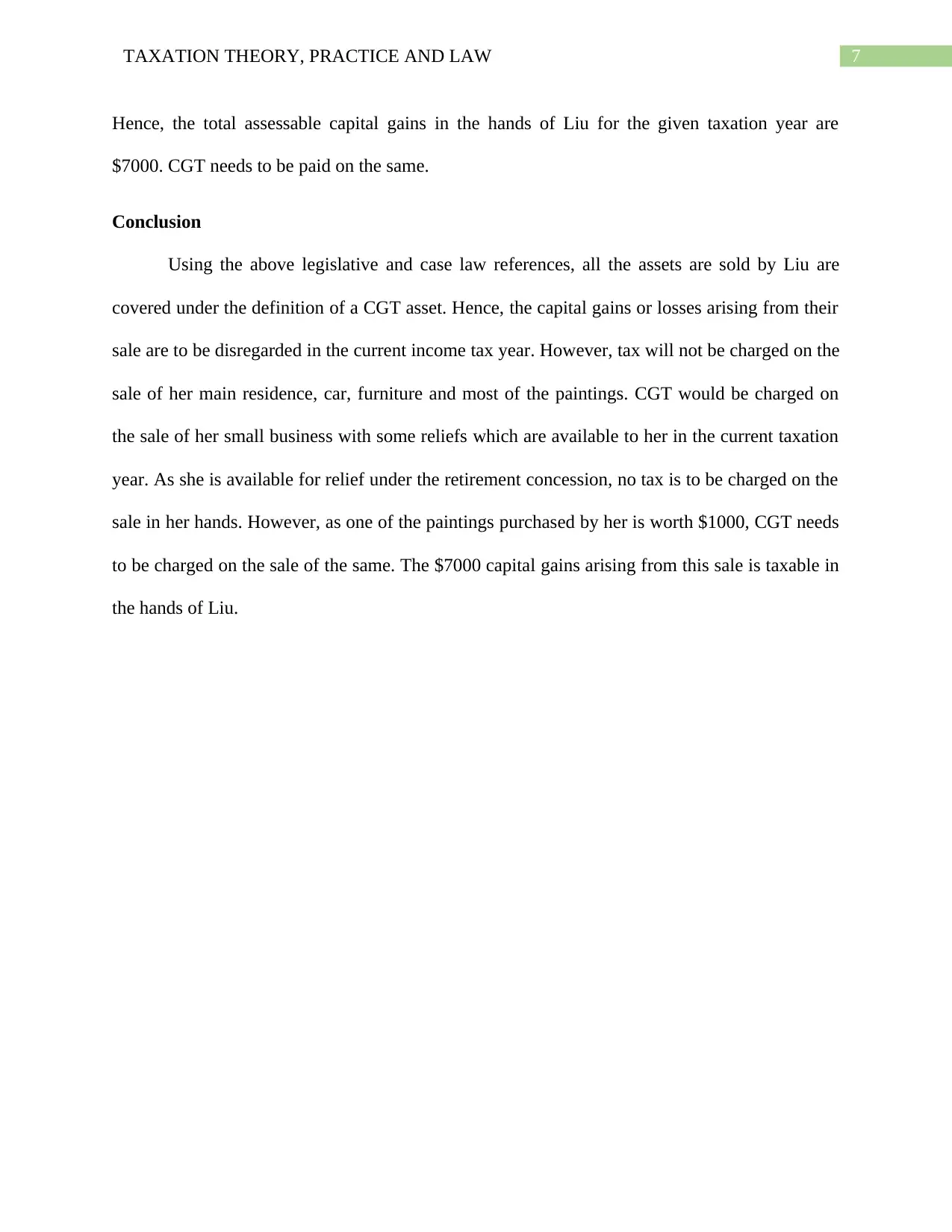
7TAXATION THEORY, PRACTICE AND LAW
Hence, the total assessable capital gains in the hands of Liu for the given taxation year are
$7000. CGT needs to be paid on the same.
Conclusion
Using the above legislative and case law references, all the assets are sold by Liu are
covered under the definition of a CGT asset. Hence, the capital gains or losses arising from their
sale are to be disregarded in the current income tax year. However, tax will not be charged on the
sale of her main residence, car, furniture and most of the paintings. CGT would be charged on
the sale of her small business with some reliefs which are available to her in the current taxation
year. As she is available for relief under the retirement concession, no tax is to be charged on the
sale in her hands. However, as one of the paintings purchased by her is worth $1000, CGT needs
to be charged on the sale of the same. The $7000 capital gains arising from this sale is taxable in
the hands of Liu.
Hence, the total assessable capital gains in the hands of Liu for the given taxation year are
$7000. CGT needs to be paid on the same.
Conclusion
Using the above legislative and case law references, all the assets are sold by Liu are
covered under the definition of a CGT asset. Hence, the capital gains or losses arising from their
sale are to be disregarded in the current income tax year. However, tax will not be charged on the
sale of her main residence, car, furniture and most of the paintings. CGT would be charged on
the sale of her small business with some reliefs which are available to her in the current taxation
year. As she is available for relief under the retirement concession, no tax is to be charged on the
sale in her hands. However, as one of the paintings purchased by her is worth $1000, CGT needs
to be charged on the sale of the same. The $7000 capital gains arising from this sale is taxable in
the hands of Liu.

8TAXATION THEORY, PRACTICE AND LAW
References
Aiatsis.gov.au. 2020. [Online] Available at:
https://aiatsis.gov.au/sites/default/files/docs/research-and-guides/native-title-research/
NativetitleTaxation.pdf [Accessed 30 Jan. 2020].
Ato.gov.au. 2020. Capital gains tax property exemption tool. [Online] Available at:
https://www.ato.gov.au/Calculators-and-tools/Capital-gains-tax-property-exemption-tool/
[Accessed 30 Jan. 2020].
Ato.gov.au. 2020. Employment income. [Online] Available at:
https://www.ato.gov.au/Individuals/Income-and-deductions/Income-you-must-declare/
Employment-income/ [Accessed 30 Jan. 2020].
Ato.gov.au. 2020. Mutuality and taxable income. [Online] Available at:
https://www.ato.gov.au/non-profit/your-organisation/in-detail/income-tax/mutuality-and-taxable-
income/?page=19 [Accessed 30 Jan. 2020].
Publicaccountants.org.au. 2020. [Online] Available at:
https://www.publicaccountants.org.au/media/1890482/Challenges-in-Accessing-the-Small-
Business-CGT-Concessions.pdf [Accessed 30 Jan. 2020].
References
Aiatsis.gov.au. 2020. [Online] Available at:
https://aiatsis.gov.au/sites/default/files/docs/research-and-guides/native-title-research/
NativetitleTaxation.pdf [Accessed 30 Jan. 2020].
Ato.gov.au. 2020. Capital gains tax property exemption tool. [Online] Available at:
https://www.ato.gov.au/Calculators-and-tools/Capital-gains-tax-property-exemption-tool/
[Accessed 30 Jan. 2020].
Ato.gov.au. 2020. Employment income. [Online] Available at:
https://www.ato.gov.au/Individuals/Income-and-deductions/Income-you-must-declare/
Employment-income/ [Accessed 30 Jan. 2020].
Ato.gov.au. 2020. Mutuality and taxable income. [Online] Available at:
https://www.ato.gov.au/non-profit/your-organisation/in-detail/income-tax/mutuality-and-taxable-
income/?page=19 [Accessed 30 Jan. 2020].
Publicaccountants.org.au. 2020. [Online] Available at:
https://www.publicaccountants.org.au/media/1890482/Challenges-in-Accessing-the-Small-
Business-CGT-Concessions.pdf [Accessed 30 Jan. 2020].
⊘ This is a preview!⊘
Do you want full access?
Subscribe today to unlock all pages.

Trusted by 1+ million students worldwide
1 out of 9
Related Documents
Your All-in-One AI-Powered Toolkit for Academic Success.
+13062052269
info@desklib.com
Available 24*7 on WhatsApp / Email
![[object Object]](/_next/static/media/star-bottom.7253800d.svg)
Unlock your academic potential
Copyright © 2020–2025 A2Z Services. All Rights Reserved. Developed and managed by ZUCOL.





